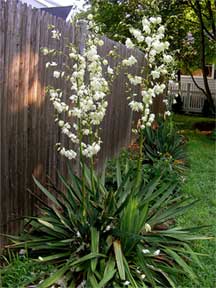“Don’t duct me. Don’t spray me. Don’t swat me. Please!” This could very well be the earnest plea of the tiny yucca moth, whose scientific name is Pronuba yuccasella.
Without this tiny moth to pollinate the creamy-white waxen blossoms of the yucca plant, the beautiful Yucca filamentosa would soon die out, for it would fail to reproduce itself.
The story of the butterflies searching out certain plants on which to lay their eggs is an old one. It is instinctive for the beautiful orange-brown monarch to lay her eggs only on the leaves of milkweed plants and for the silver-spangled fritillary to lay her eggs only on the leaves of violets.

However, the relationship between milkweed and monarch and fritillary and violet ends right there. The milk-weeds and the violets are not wholly dependent on these butterflies for their very existence. Bees and other insects can, and do, perform the transfer of pollen, thus fertilizing these flowers.
But this function other insects cannot perform for the yucca plant. Pronuba yuccasella is the one and only creature who can perform this important task.
And she does this in a marvelous and most interesting way. She does it with such purposefulness, you would think she had planned ahead. But it is instinct which guides her. This small whitish moth gathers a quantity of pollen in her jaws and rolls it into a ball, often three times as big as her head. She then pierces a hole in a yucca blossom’s reproductive organ and lays her eggs inside the opening. Her egg laying finished, she plugs the ball of pollen into the hole, thus fertilizing the blossom.
Some time later, inside the enclosure, caterpillars hatch from the moth’s eggs and feed upon some of the seeds born of the fertilization. Without these special seeds the caterpillars would die. When they have eaten their fill of the seeds, they eat a hole in the wall of the enclosure and escape. And the life cycle of Pronuba begins all over again caterpillar, moth, egg.
Such is the unparalleled cooperation of the plant and insect that neither can propagate without the other. This extraordinary case of symbiosis was disclosed by Charles Valentine Riley in 1872.
The white or cream-colored cup-shaped flowers of the yucca, resembling huge lilies of the valley, are borne in clusters on a many-branched central stalk. Each blossom, open only for one night, is said to shed a heavy fragrance especially attractive to Pronuba. Other insects steer clear of it.
As the lovely blossoms wither, green pods replace them by late July. These pods become brown in autumn and dry enough to split open and spill the ripened seeds on the ground.
The plants are propagated by seeds, offsets, and stem cuttings, and also by rhizome cuttings under glass. In our age of insect dusts and sprays it is wise to plant this queen of desert blossoms with an eye to its future.
If you can plant your yucca in a roomy and isolated garden spot, it will reproduce itself, and you will reap the reward of an impressive mass planting. Then when some flower lover sees your showy yuccas in bloom and compliments you with the old saw, “You sure know your onions,” you can reply, “I know my bugs. I know Pronuba yuccasella.”
